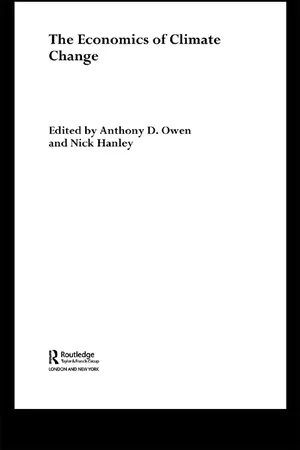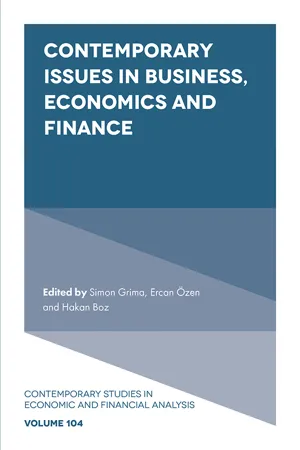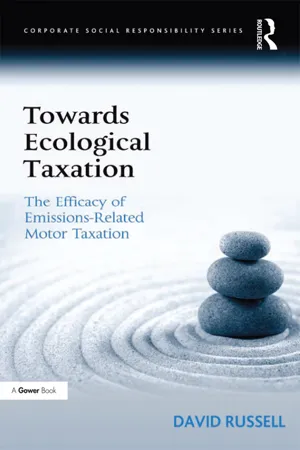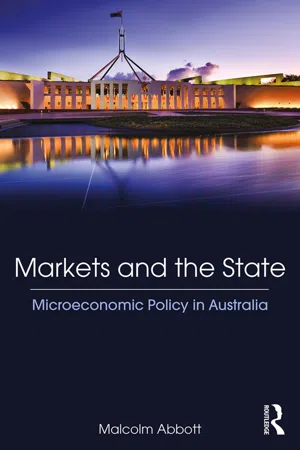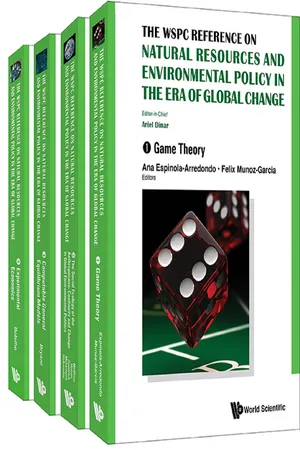Economics
Carbon Tax
A carbon tax is a fee imposed on the burning of carbon-based fuels, with the aim of reducing carbon dioxide emissions. It is designed to incentivize individuals and businesses to reduce their carbon footprint by increasing the cost of activities that contribute to climate change. The revenue generated from the tax can be used to fund environmental initiatives or offset other taxes.
Written by Perlego with AI-assistance
Related key terms
9 Key excerpts on "Carbon Tax"
- eBook - ePub
- Arnaud Brohé(Author)
- 2017(Publication Date)
- Routledge(Publisher)
2 . These taxes aim to change the relative prices of goods or energy sources, on the basis of their CO, content, in order to steer decisions made by actors towards low carbon production and consumption. This type of tax may be primarily motivated by a desire to regulate diffuse emissions, however other factors explain its appeal to many governments. For example, it is a new source of resources for the state, particularly as company tax rates have dropped. Supporters of Carbon Taxes argue that tax structures should be modified to reduce taxes deemed to cause distortions, such as taxes on earned income (Bosquet, 2000). For fossil fuels, Carbon Taxes are also a way of intercepting rents on oil and other fuels (Elbeze and de Perthuis, 2011). At this point, it is important to be clear about the fundamental difference between Carbon Taxes and energy taxes. Whereas Carbon Taxes have a direct effect on CO, emissions, energy taxes aim to rationalize energy use whatever the carbon content. A legislator can decide to tax these two areas in a complementary wayAn increasing number of European countries and Canadian provinces have imposed a tax on CO, emissions. Finland was the first country to introduce a Carbon Tax in 1990. Sweden, Denmark, the Netherlands and the United Kingdom followed, with reforms that moved the fiscal burden from labour to CO2 emissions and energy consumption. These environmental taxes have increased progressively in Europe, now accounting for 25 billion EUR of income, which has made it possible to reduce labour taxation (Ekins and Speck, 2011). These countries were joined more recently by Switzerland (2008) and Ireland (2010) (Elbeze and de Perthuis, 2011). During this time, the tax rate has increased progressively but significantly. In Sweden, the tax rate for households has risen from around 25 EUR in the early 1990s to more than 100 EUR per tonne of CO, in 2011 (Elbeze and de Perthuis, 2011). It was possible to impose a high level of taxation in the Scandinavian countries as income tax and social contributions were reduced at the same time (green tax shift ). - eBook - ePub
- Nick Hanley, Anthony D Owen(Authors)
- 2004(Publication Date)
- Routledge(Publisher)
6 The role of economic instruments:
Fanny Missfeldt and Jochen Hauff
What is a Carbon Tax and what is emissions trading?
Emissions trading and Carbon Taxes are two of several instruments a policy maker can choose from to reduce the emission of pollutants, including greenhouse gases. Along with subsidies, they belong to the class of economic instruments of environmental protection policy. As such, they contrast with the most common approach to pollution control, the ‘command and control’ measures, which include, for example, technical and emissions standards (Baumol and Oates 1988).Pigou (1946) has been considered as the father of taxes imposed to limit negative environmental externalities, such as climate change. Accordingly, Pigouvian taxes are set at the level of the shadow price of the externality. The idea of emissions trading was first suggested by Crocker (1966) and Dales (1968). Its first practical application dates back to 1977, when the first emissions trading programme was adopted as part of amendments to the US Clean Air Act.A Carbon Tax is a tax imposed on the total quantity of greenhouse gases emitted. If, for example, a tax rate, t, of 50 Eurocent per tonne of carbon emitted is imposed, and a company emits 40 tonnes of carbon per year, then the annual Carbon Tax payable by the company is 200 Euro. Carbon Taxes are commonly limited to CO2 emissions, but they can also be applied to other greenhouse gases such as methane or nitrous oxide.Emissions trading involves the issuance of allowances or permits to emit a certain quantity (for example a tonne of CO2 ) of greenhouse gases over a certain period of time (for example a year). For example, if the companies in a city emit a total of 2,000 tonnes of carbon per year, and the city council decides to limit emissions to a total of 1,400 tonnes of carbon, then 1,400 one-tonne allowances are allocated to the emitters of greenhouse gases. Say there are two emitters in the city, a cement factory and a bus and taxi company. The cement factory receives emission allowances of 600 tonnes of carbon per year. If the cement factory exceeds those 600 tonnes, it may buy the amount from the bus/taxi company, under the condition that the latter has generated emissions reductions in excess of its own target. Put differently, both companies can trade emissions rights. Box 6.1 - Simon Grima, Ercan Özen, Hakan Boz(Authors)
- 2020(Publication Date)
- Emerald Publishing Limited(Publisher)
Acosta, 2015 ):- Allowing public revenue.
- Providing environmental effectiveness.
- Transparent and simple.
- Economic efficiency.
- Accurate costs.
A Carbon Tax is a charge on the combustion of carbon-based fuels such as coal, oil and greenhouse gases. The aim is to reduce the use of fossil fuels that damage the climate and cause global warming. At this point, Carbon Tax is seen as the only way to pay for the climate damage caused by the release of carbon dioxide in the atmosphere. The Carbon Tax set to a sufficiently high value rewards those who do not use these fuels economically. Therefore, it becomes an element that motivates the use of clean energy (CTC). The tax to be applied for greenhouse gas emissions needs to be handled in a broad context in terms of both efficiency and justice principles. For example, home heating systems, factories, airplanes, power plants and cars should have the same carbon price. But this also leads to the following challenges (Marron et al., 2015 ):- Presence of greenhouse gases other than carbon dioxide.
- Difficulty in tracking emissions.
- There are multiple ways to generate carbon emissions.
- The need to extend credit for the purpose of removing carbon emissions from the atmosphere.
Consequently, according to the analysis, Carbon Tax encourages investments to be made for clean energy, as well as reducing carbon pollution. However, there are doubts as to how low-income communities will be affected by the Carbon Tax due to these positive characteristics as well as the negative impact it has on social welfare (Carbon Tax Forum; Chi, Ma, & Zhu, 2012- eBook - ePub
Towards Ecological Taxation
The Efficacy of Emissions-Related Motor Taxation
- David Russell(Author)
- 2016(Publication Date)
- Routledge(Publisher)
Stern (2007) observes that taxation may be used to create an explicit price for carbon. Carbon Taxes may be levied on fossil fuel users according to the levels of carbon emissions when the fuel is combusted.For example, the levels of carbon emitted from coal is considerably higher than oil, to produce the same value of heat. Similarly the levels of carbon emission are higher for oil than natural gas.Pearce (1991) concluded that a Carbon Tax is most likely to manifest as a specific excise tax on the carbon content of fuels. Such a tax would vary for each fossil fuel (oil, coal and gas) because of the differences in the carbon content. Moreover, Smith (1993) suggested that the close association between CO2 emissions and the carbon content of fossil fuels burnt provides further justification why the use of Carbon Taxes is an appropriate application of such a fiscal instrument.Pearce (1991) suggested that a Carbon Tax could be consumption or production-based, the latter would effectively be an extraction tax and is likely to provide benefit to those carbon-exporting countries with oil, coal and gas resources and would disadvantage net carbon importers.Much of the discussion of Carbon Taxes in the literature relates to consumption as this is likely to have the greatest effectiveness in curtailing carbon production via fossil fuel consumption and it is on this basis that Carbon Taxes are discussed further.Pearce (1991:940) discussed the role of Carbon Taxes and suggested ‘while most taxes distort incentives an environmental [carbon] tax corrects a distortion, namely the externalities arising from the excessive use of environmental services’. Pearson & Smith (1990) argued that the environmental costs of CO2 emissions remain the same irrespective of their source. As a consequence all CO2 generating activity should tolerate a charge in proportion to the amount of CO2 produced. Carbon Taxes may prove to be a valuable instrument for reducing CO2 emissions, not least because Carbon Taxes are an on-going incentive to derive ever cleaner technology and adopt energy conservation measures (Pearce 1991 - eBook - ePub
Blueprint 2
Greening the World Economy
- David Pearce(Author)
- 2013(Publication Date)
- Routledge(Publisher)
In effect, the Carbon Tax is assumed to have the same effect as an increase in the price of energy on an economy totally dependent on energy imports. Yet substantial revenues will be generated by the tax, and this money could be put to good use nationally. Of course, we already have taxes that raise revenues. The problem with these is that most introduce unwelcome distortions into the economy. A tax on income creates disincentives to work: people find it more attractive to substitute untaxed leisure for income-producing activities. Similarly, a tax on investment earnings provides an incentive for consumers to substitute consumption now for consumption later; the rate of savings is depressed. In the United States, such distortions are estimated to impose a total cost of 4-7 per cent of GNP, and a marginal cost of 15–45 cents per extra tax dollar collected (Dower and Repetto, 1990). A Carbon Tax actually corrects a distortion by making polluters pay for the environmental costs of their actions. Imposition of such a tax would therefore not only help to protect the environment, but also substitute for other revenue sources that damage the economy. At the margin, this substitution could have a significant impact. Bye, Bye and Lorentsen’s (1989) model for Norway offsets the gain in revenue from a Carbon Tax by reducing the tax on wage income, and increasing transfers to households. Unfortunately, the authors do not show the tax reform’s effect on the costs of the emission reductions. However, the offsetting changes in income tax and benefit policy may help to explain why the Carbon Tax is predicted to reduce GDP in 2000 by only 1 per cent. Barker and Lewney (1990) offset the gains in Carbon Tax revenues by lowering the Value Added Tax. When the Carbon Tax i$ set to reduce emissions 18.5 per cent in 2005, VAT falls to 11.9 per cent (from 15 per cent). When the Carbon Tax is set to reduce emissions 33 per cent in 2005, VAT falls to 6.7 per cent - eBook - ePub
Markets and the State
Microeconomic Policy in Australia
- Malcolm Abbott(Author)
- 2018(Publication Date)
- Routledge(Publisher)
It also represents a disproportionate burden on (rural) communities lacking public transport. Table 18.2 provides the level of petrol taxes used across a range of countries. The second is a Btu tax – a per unit charge based on the energy content of fuel, measured in British thermal units (Btu), which encourages fuel switching and conservation by raising fuel prices. It is a tax on the consumption of fossil fuels (coal, oil and natural gas) to discourage consumption, reduce carbon dioxide emissions and promote other measures against the greenhouse effect. As the carbon content of fuels varies, fossil fuels would be taxed at different rates. Table 18.3 provides a list of the various countries that have Carbon Taxes, including Australia’s scheme, which operated between 2012 and 2014. p.271 In addition, an emissions trading (or cap and trade) plan is a method used to control pollution by providing economic incentives for achieving reductions in the emissions of pollution. A central authority or government will set a limit or cap on the amount of a pollutant that can be emitted. Companies or other groups that emit the pollutant are given credits or allowances which represent the right to emit a specific amount. The total amount of credits cannot exceed the cap, limiting total emissions to that level. Companies that pollute beyond their allowances must buy credits from those that pollute less than their allowances. In effect, the buyer is being fined for polluting, while the seller is being rewarded for having reduced emissions. The more firms that need to buy credits, the higher the price of credits becomes, which makes reducing emissions cost effective in comparison. The overall goal of an emissions trading plan is to reduce pollution, and in some cases the cap may be lowered over time. In other systems, a portion of all traded credits must be retired, causing a net reduction in emissions each time a trade occurs - eBook - ePub
Putting the Genie Back
Solving the Climate and Energy Dilemma
- David Hone(Author)
- 2017(Publication Date)
- Emerald Publishing Limited(Publisher)
internal carbon value . The internal value, when used by government, can be based on the social cost of carbon as part of a given stabilisation goal. In business, the internal value reflects the expected impact that medium to long-term government policy will have on a particular investment.Some observers have concluded that an internal business approach should operate as an actual cost of carbon emissions within the respective business, such that the business behaves as if it were subjected to an external Carbon Tax operating at the same value. This would be done in the absence of an external carbon price driver, therefore acting as a stand-in for the lack of government action. But this is not what is happening or what is meant by an internal carbon value. There is an element of wishful thinking operating here, with some believing that internal carbon valuation can lead to widespread emission reductions as a major business-led initiative.Rather, the internal carbon value also referred to as a shadow carbon value or carbon screening value is normally a mechanism used to manage the future regulatory risk that parts of the company or a future project may be exposed to. For example, if a certain investment is to be made, that investment is tested against a variety of possible future conditions, which could include an eventual cost incurred by the expected emissions of carbon dioxide. Although the project may not immediately be exposed to such a cost, the introduction of climate legislation may bring about exposure, which in turn could threaten the future viability of the asset. The application of a shadow carbon value applied when the investment proposal is being assessed allows the investor to reconsider the project, change the scope, modify the design or simply accept the level of risk and proceed. - eBook - ePub
- Ana Espinola-Arredondo, Felix Munoz-Garcia, Richard A Matthew, Connor Harron, Kristen Goodrich, Bemmy Maharramli;Evgenia Nizkorodov;Tony Bryant;Anabela Botelho(Authors)
- 2016(Publication Date)
- WSPC(Publisher)
Thus there are two important fronts to appraise the costs of climate change policies. On the one hand, the domestic front, in terms of how wages are determined institutionally or by the market, because additional costs could be passed through to wages and therefore reduce employment (with the obvious political consequences). The second front is the external; well-intended individual countries initiatives could be jeopardized by loss of competitiveness when not accompanied by the rest of the world (since a simultaneous move of all countries that could help to stabilize the relative changes in competitiveness).Were domestic Carbon Taxes accompanied by the rest of the world, the negative impacts would be reduced. We also find that the composition effect, that is the reallocation of resources due to taxes, is relevant for reducing the costs in terms of GDP.However, it is possible that the reduction of the absolute level of emissions achieved were not enough to stop the process of growth of those emissions in the long run, beyond the safety thresholds. Carbon Taxation helps to obtain delay in the accumulation of total GHG in the atmosphere, even in those cases for which the emission-intensity of the economies is lowered. But growing population and per capita consumption cannot necessarily be compensated only with a shift of the industrial structure towards less polluting activities.Thus, the presence of technological alternatives is a key element for the evaluation of the effectiveness of the reduction of emissions. Therefore it becomes relevant to know how healthy an economy is in the external front to evaluate if a new technology will be used the use of the funds provided by environmental taxes. However, a faster replacement of polluting technologies could be far from fast and easy. The capital already sunk in old technologies could have no alternative use, and could accept deep reductions in its remuneration before leaving the activity or becoming obsolete (see Chisari et al - eBook - ePub
- Silvia Tiezzi, Chiara Martini(Authors)
- 2014(Publication Date)
- Routledge(Publisher)
They find that a Carbon Tax just above €10/tCO 2 could reduce emissions by some 25 per cent, with little impact on overall welfare (less than 1 per cent for a €30/tCO 2 tax). Substitution between capital and energy is indicated as a critical factor. Wissema (2007) augments the same model by allowing for unemployment and endogenous labour supply and pairs Carbon Taxation with revenue recycling. She finds lower indirect taxes bring about only a ‘weak double dividend’, 10 whereas a strong negative welfare result is associated with lower labour taxes. This result is due to the loss in households’ leisure, which in a context of almost full employment is necessary to meet higher labour demand. Conefrey et al. (2008) again use HERMES, but in a different way this time. They consider a €20/tCO 2 tax, but instead of using a dynamic no-tax baseline scenario, they maintain the economic structure fixed at its 2005 level. This way, they can isolate the equilibrium effects of the tax from any other unrelated changes in the economy – effectively, more a CGE type of exercise. Two recycling options are considered, namely household transfers and lower income taxes. Only with the latter, a double dividend is likely. International competitiveness of manufacturing and services is the main channel through which the hypothesized tax reforms affect the economy. The impact on emissions turns out to be very limited: a reduction of around 2 per cent at most. Turning to the works focused on distributional implications, Scott (1992) finds that the first-round effects of a Carbon Tax would be markedly regressive. 11 This conclusion is based on the pattern of fuel consumption across household income deciles as it emerges from the 1987 HBS. Scott and Eakins (2004) repeat the work with more recent data and obtain similar results
Learn about this page
Index pages curate the most relevant extracts from our library of academic textbooks. They’ve been created using an in-house natural language model (NLM), each adding context and meaning to key research topics.

